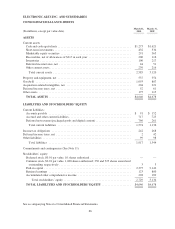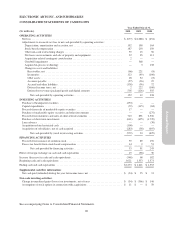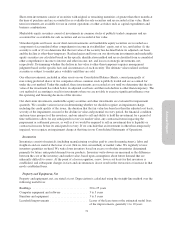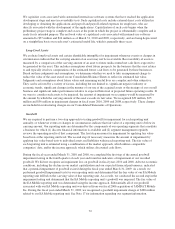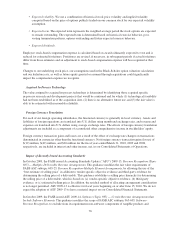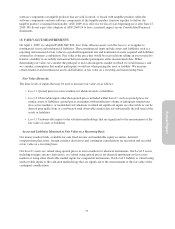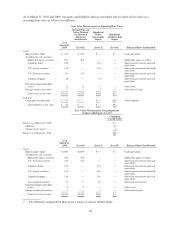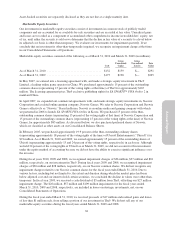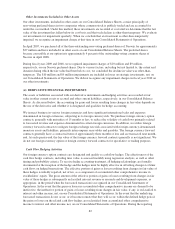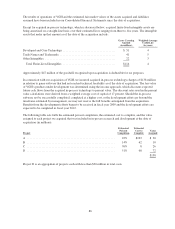Electronic Arts 2010 Annual Report Download - page 154
Download and view the complete annual report
Please find page 154 of the 2010 Electronic Arts annual report below. You can navigate through the pages in the report by either clicking on the pages listed below, or by using the keyword search tool below to find specific information within the annual report.•Expected volatility. We use a combination of historical stock price volatility and implied volatility
computed based on the price of options publicly traded on our common stock for our expected volatility
assumption.
•Expected term. The expected term represents the weighted-average period the stock options are expected
to remain outstanding. The expected term is determined based on historical exercise behavior, post-
vesting termination patterns, options outstanding and future expected exercise behavior.
•Expected dividends.
Employee stock-based compensation expense is calculated based on awards ultimately expected to vest and is
reduced for estimated forfeitures. Forfeitures are revised, if necessary, in subsequent periods if actual forfeitures
differ from those estimates and an adjustment to stock-based compensation expense will be recognized at that
time.
Changes to our underlying stock price, our assumptions used in the Black-Scholes option valuation calculation
and our forfeiture rate, as well as future equity granted or assumed through acquisitions could significantly
impact the compensation expense we recognize.
Acquired In-Process Technology
The value assigned to acquired in-process technology is determined by identifying those acquired specific
in-process research and development projects that would be continued and for which (1) technological feasibility
had not been established as of the acquisition date, (2) there is no alternative future use, and (3) the fair value is
able to be estimated with reasonable reliability.
Foreign Currency Translation
For each of our foreign operating subsidiaries, the functional currency is generally its local currency. Assets and
liabilities of foreign operations are translated into U.S. dollars using month-end exchange rates, and revenue and
expenses are translated into U.S. dollars using average exchange rates. The effects of foreign currency translation
adjustments are included as a component of accumulated other comprehensive income in stockholders’ equity.
Foreign currency transaction gains and losses are a result of the effect of exchange rate changes on transactions
denominated in currencies other than the functional currency. Net foreign currency transaction gains (losses) of
$(19) million, $(49) million, and $20 million for the fiscal years ended March 31, 2010, 2009 and 2008,
respectively, are included in interest and other income, net, in our Consolidated Statements of Operations.
Impact of Recently Issued Accounting Standards
In October 2009, the FASB issued Accounting Standards Update (“ASU”) 2009-13, Revenue Recognition (Topic
605) — Multiple-Deliverable Revenue Arrangements. This guidance modifies the fair value requirements of
FASB ASC subtopic 605-25, Revenue Recognition-Multiple Element Arrangements, by allowing the use of the
“best estimate of selling price” in addition to vendor specific objective evidence and third-party evidence for
determining the selling price of a deliverable. This guidance establishes a selling price hierarchy for determining
the selling price of a deliverable, which is based on: (a) vendor-specific objective evidence, (b) third-party
evidence, or (c) estimated selling prices. In addition, the residual method of allocating arrangement consideration
is no longer permitted. ASU 2009-13 is effective for fiscal years beginning on or after June 15, 2010. We do not
expect the adoption of ASU 2009-13 to have a material impact on our Consolidated Financial Statements.
In October 2009, the FASB issued ASU 2009-14, Software (Topic 985) — Certain Revenue Arrangements that
Include Software Elements. This guidance modifies the scope of FASB ASC subtopic 965-605, Software-
Revenue Recognition, to exclude from its requirements non-software components of tangible products and
76


